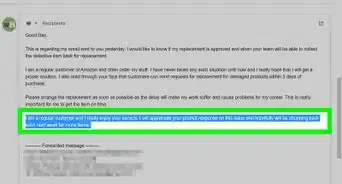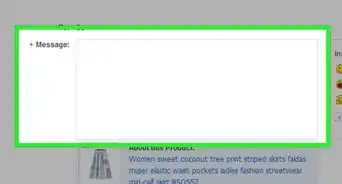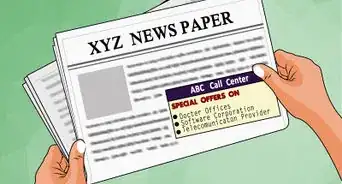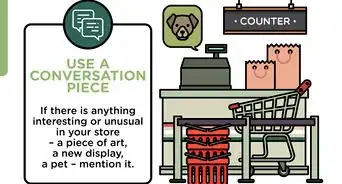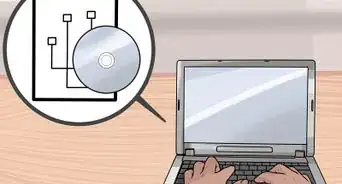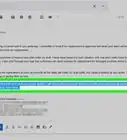This article was co-authored by Sabrina Grover, LMSW. Sabrina Grover, LMSW is a Licensed Master Social Worker (LMSW) who earned her degree in Advanced Clinical Practice from New York University. Sabrina has experience working in substance abuse recovery centers and schools where she gained experience providing evidence-based treatment to children, adolescents, adults, and families. Sabrina specializes in Dialectical, Narrative, and Cognitive Behavioral Therapies. She has particular expertise in treating clients struggling with grief, complex trauma, interpersonal difficulty, family conflict, anxiety, and depression. She commits to providing a supportive environment for everyone who commits to growth and offering a warm, non-judgmental atmosphere.
There are 12 references cited in this article, which can be found at the bottom of the page.
This article has been viewed 267,116 times.
Anticipating a customer's needs is an important part of most retail and wholesale businesses, especially in a more challenging retail environment so they choose to come back. Anticipating needs also provides opportunities for personal and professional growth. A business that takes the extra step of anticipating and providing for an obvious corollary need can generate loyal, repeat customers; and even a humble clerk who is alert to the needs of the customer standing in front of them is sure to advance.
While much of this may involve remembering or noting the desires of the individual customer, it also largely means putting yourself in a customer's place, which takes a little practice. The needs of a truck driver versus a pregnant mother with children may differ, even for the purchase of a cup of coffee. Below are some steps to help you improve your anticipation of a customer's needs.
Steps
Anticipating Future and Recurring Customers
-
1Apply Customer Relationship Management (CRM) tools.[1] These tools can be purchased as software, or can be put together through a marketing team. CRM tools will help you gather information about your customers involving:
- Tracking marketing success
- Tracking customer relationships
- Tracking customer demographic
- Tracking customers who have responded to promotional material.
- Tracking the success of your marketing activities
-
2Employ “next best action” (NBA) approach. This active approach can anticipate what your customer may need in the future. By employing this, you may exceed your customer’s expectation and gain a loyal following.
- For example, consider if you own a baking company. A woman comes to order a wedding cake for her daughter’s wedding. As a baker, you could suggest an appropriate wedding topper or serving knife to go with her order. By anticipating the woman’s future actions, you may be able to promote additional sales.
Advertisement -
3Have a clear vision for the future. You want to have clear answers to important questions that will define the future of your business. These will both financially and customer centered. This will help you anticipate the needs of not only your customers, but also you business and staff. Ask yourself:
- “What do I want for my customers?”
- “What sort of customers do I want to attract?”
- ”Why does my business exist?”
- ”How can I present this vision my employees, stakeholders, customers?”
-
4Be accountable. While the old adage “the customer is always right" may be a bit cliche, it still holds truth in the business world. To garner repeat and loyal customers, it is important for you to be accountable for your company’s actions.[2]
- Accountability happens as soon as the customer walks through your door. Greet your customers at the door to show that you have a personal interest in their well-being.
- Be accountable for any mistakes. Whether it is a damaged product, or a mislabeled price, it is your responsibility to work with the customer. Offer a free replacement or reduced price. Offer the customer to purchase the product at the advertised price. This will show integrity as well as accountability.
-
5Be honest with your customers, employees, and/or employers. Honesty is the best practice. If a customer asks about a mistake in a project, be honest with them. They will be more likely to respond positively.[3]
- Do not lie to a customer about a product or project in hopes for a better sale. This will not cultivate a good relationship for the future. When you are anticipating future business, think about what would happen if the offended party would find out the truth.
-
6Be humble. Humility keeps the mind open.[4] . To grow as an individual and a company, you must maintain an open mind for change and evolution.
- Be aware of your surroundings -- Pay attention to whom you are speaking. Be aware of their body language and what is appropriate given the situation.
- Be aware of your limitations -- Do you not over-extend yourself of what you are capable of doing or promising.
- Put others first -- This could be your clients or employees. This will help you maintain respect and make future difficult decisions easier to manage.[5]
Actively Listening to Your Customers
-
1Learn to actively listen.[6] Active listening is an important skill to learn to be an effective communicator. Effective communication is an important tool to anticipate customer’s needs. To actively listen, try some of these tips[7] :
- Face your audience and maintain eye contact.
- Stay alert, but not overbearingly so. You do not want to intimidate your audience. Relax your body language, but stay alert by maintaining eye contact and nodding your head when appropriate.
- Keep an open mind. If you already have decided on an answer or solution, you will be more likely to not actively listen to your audience. Try and listen to all solutions presented before drawing conclusions.
- Do not interrupt the speaker. This may confuse the speaker or distract her. Even if you are feeling a strong emotional response to what is being said, wait until the speaker is finished before responding.
- Try and picture what is being said. This will help understand and listen more effectively.
- Ask questions. Asking questions by repeating what the speaker said is an excellent way to make sure you have fully understood what she has said. Say something like: “I hear you talking about [x]; what do you mean by that?” Or, try using what she has said as a way to establish your own point: “I hear you are concerned about the price of this item; let me tell you how this special, handcrafted item is made.” This will help you audience know that you really have listened to them.
-
2Employ audience analysis Audience analysis is the process of understanding, or gathering information about, the traits of your consumers.[8] This is beneficial in many ways; it will allow you to anticipate your customer’s buying habits based on past actions or behavior. To participate in audience analysis, consider the following:
- Avoid making assumptions about your customers. Assumptions may lead to sloppy research and unfounded conclusions.
- Ask experienced employees or coworkers about the type of customers they encounter. Have them give you detailed descriptions including gender, appearance, and behavior. For example, perhaps an employee at a grocery store might say something like: “I was the cashier to a young woman in her 20s. She was dressed in running shoes, biking shorts, and a tank top. She looked athletic and was purchasing healthy fruits and vegetables.” This scenario will help garner information about your clientele.
- Observe your customers first hand. Just by being on the floor and watching your customers, you will observe specific traits and patterns of the people around you.
-
3Listen to your past customer’s views. A part of actively listening to your customers, is actively engaging in improvement. Getting your clients to voice their opinions will help build trust for future customers, and allow you to anticipate what those needs may be.
- Allow customers (with some monitoring) to post on your business’s social media page.
- Encourage customers to write reviews of your business.
- Try and improve your business practices and anticipate customer’s needs based on reviews and comments.
Applying What You Already Know
-
1Put yourself in your customer’s shoes. Listening to your customer’s concerns is one way to help anticipate future needs, but putting yourself in their shoes is entirely different. [9] . Try using your own products or practicing being your own customer to identify what future problems and frustrations may be.
- For example, if you are a photograph, practice a shoot on a friend. Your friend will most likely be more honest with you on your actions.
- Or, have a fellow photographer perform a shoot on you. Identify how you feel about certain aspects of this practice. Would you change any of the experience for a customer?
-
2Hire customer-centered employees. Customers value good customer service. [10] A friendly smile and a cheerful disposition goes a long way to ensure business loyalty. Further, a customer-centered employee is more in tune with the future frustrations that may arise.
-
3Apply data that you already have. Anticipating a customer’s reactions does not necessarily require new research or data. Apply what you already know about your customers to make an educated guess on what may happen in the future. [11]
- For example, if you know your market is a small town in the Midwestern, United States, you can already predict what their beliefs may be toward a local sports team. You can use this knowledge to anticipate how well an item may sell.
-
4Be prepared when conversing with customers. Chances are, if you have been in business for any length of time, you already have a mental list of “frequently asked questions” (FAQS). Before sitting down with a client or customer remember the commons frustrations, problems, and solutions to better prepare yourself for what may be asked. [12]
Community Q&A
-
QuestionHow can I start a house cleaning business?
 Community AnswerPut yourself out there. Tell your family and friends that you want to start the business. Put ads on Facebook and other online sites.
Community AnswerPut yourself out there. Tell your family and friends that you want to start the business. Put ads on Facebook and other online sites. -
QuestionWhat are the actions taken to meet the needs of customers known as?
 Community AnswerResponsive fulfillment of the customer's needs and/or wants. This phrase indicates a direct and successful on-target response to the customer's needs via a product or service.
Community AnswerResponsive fulfillment of the customer's needs and/or wants. This phrase indicates a direct and successful on-target response to the customer's needs via a product or service. -
QuestionHow should I identify a customer's expectations?
 Community AnswerIn general, many customers have the same expectations: quick service, friendly employees, and well-stocked items. To find out what a customer's more specific expectations are, you can just talk to them and ask what you can do for them. They'll be happy to tell you what they need.
Community AnswerIn general, many customers have the same expectations: quick service, friendly employees, and well-stocked items. To find out what a customer's more specific expectations are, you can just talk to them and ask what you can do for them. They'll be happy to tell you what they need.
References
- ↑ http://www.cose.org/News/Press%20Releases/General/Anticipate%20Needs%20Ahead%20of%20the%20Customer.aspx
- ↑ http://www.industryweek.com/companies-amp-executives/anticipating-customer-needs
- ↑ http://www.forbes.com/sites/joefolkman/2014/11/14/how-do-you-score-the-8-great-accountability-skills-for-business-success/
- ↑ https://hbr.org/2014/05/the-best-leaders-are-humble-leaders
- ↑ http://www.forbes.com/sites/jeffboss/2015/03/01/13-habits-of-humble-people/
- ↑ http://www.forbes.com/sites/carminegallo/2014/05/28/stop-listening-and-start-anticipating-your-customers-needs/
- ↑ http://www.forbes.com/sites/womensmedia/2012/11/09/10-steps-to-effective-listening/
- ↑ http://www.saylor.org/site/wp-content/uploads/2013/12/CUST104-OC-2.1-Audience-Analysis-to-Anticipate-Needs-FINAL.pdf
- ↑ http://business.time.com/2012/02/27/put-yourself-in-your-customers-shoes/
- ↑ http://www.i4cp.com/productivity-blog/2014/07/15/5-ways-hr-helps-your-company-anticipate-customers-future-needs
- ↑ http://www.mediapost.com/publications/article/215899/waiting-to-wow-three-keys-to-anticipating-consume.html
- ↑ http://www.ihi.org/resources/Pages/Changes/PredictandAnticipatePatientNeeds.aspx
















